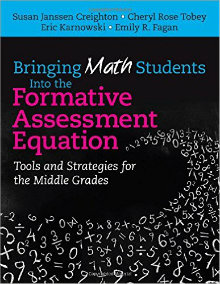Involving Math Students in Formative Assessment
Bringing Math Students into the Formative Assessment Equation: Tools and Strategies for the Middle Grades
By Susan Janssen Creighton, Cheryl Rose Tobey, Eric Karnowski, and Emily R. Fagan
(Corwin, 2015 – Learn more)

Bringing Math Students into the Formative Assessment Equation: Tools and Strategies for the Middle Grades is an excellent book for anyone presenting or moving a school district towards learning targets, learning standards, learning goals – whichever name you chose.
This book is in a league of its own, focusing solely on the work of the middle level educator, with more examples than I’ve ever seen for middle school mathematics. If you are a math teacher who has attended professional development sessions on writing learning goals that were presented by non-math teachers, I think you’ll find that this book answers all the questions those presenters dodged when asked.
What the authors have included

The best parts for me: seeing how to write learning goals in student friendly language and how to write and align success criteria to go with those goals. In this book, the learning target is overarching and the success criteria indicate how to get there, including steps that show progress towards an understanding of the learning goal.
For example, on page 39 in figure 2.4, a teacher states: “I wrote learning objectives like this…Students will be able to create tables and graphs from a given data set.” Then the authors share their idea of a better version of the goal, using success criteria aimed at helping students assess their own progress.
The revised version, on page 39 in figure 2.4, states “I will understand how a table and graph represent the same data. Success Criteria – I can create a table using data – I can create a graph using the same data – I can explain how the same data are represented both in the table and on the graph.”
As I looked at this example, I realized that many times I’ve written learning goals much like the first version. This school year I will be trying to reshape and realign my goals and success criteria to be more detailed and similar to the second version.
In addition to the print version, Bringing Math Students into the Formative Assessment Equation has an online component with interactive sections aligned to each book chapter. The additional resources include videos, print resources, poster materials, and templates for writing learning goals and assessing student progress (though at times the site can be tricky to navigate).
Collecting student feedback
As a teacher, I also found value in the section that can be used to collect student feedback about their learning. The section included figures for students to select indicating whether they have it, are getting there, or are confused. For my classroom, I could see myself immediately using “Template 5: Self Reflection” (one of a set of downloadable tools). This brief form has students list what they did to practice, whom they practiced with, and what type of mistake they had been making. I will be merging this form into the top of a student correction sheet that they do with assessments to show proficiency.
Overall, if you work in or for a school that posts and uses learning goals, I would suggest your school or district have at least one copy of this useful book. It provides good examples for those learning about learning goals and offers many ideas to expand the effort for those who already are using them.
Maia Fastabend is a 6th year teacher from Southern Oregon who when not teaching can be found whitewater kayaking or trail running. She has experience teaching 6th-8th grade general math and advanced math, and recently has found her niche teaching remedial/support. Musings about her teaching and current topics can be found at http://teachrunlife.blogspot.com/.





























